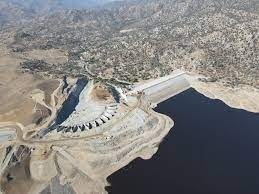Labyrinth Spillways: Difference between revisions
No edit summary |
No edit summary |
||
| Line 14: | Line 14: | ||
“The flow capacity of a weir is largely governed by the weir length and crest shape. A labyrinth weir is a linear weir folded in plan-view; these structures offer several advantages when compared to linear weir structures. Labyrinth [[weirs]] provide an increase in crest length for a given channel width, thereby increasing flow capacity for a given upstream head. As a result of the increased flow capacity, these weirs require less free board in the upstream reservoir than linear weirs, which facilitates flood routing and increases reservoir storage capacity under base flow conditions (weir height may be increased). In addition to [[spillways]], labyrinth weirs are also effective drop structures, energy dissipaters, and flow aeration control structures."<ref name="Crookston">[[Labyrinth Weirs, Dissertation by Brian Crookston, Utah State University|Labyrinth Weirs, Dissertation by Brian Crookston, Utah State University, 2010]]</ref> | “The flow capacity of a weir is largely governed by the weir length and crest shape. A labyrinth weir is a linear weir folded in plan-view; these structures offer several advantages when compared to linear weir structures. Labyrinth [[weirs]] provide an increase in crest length for a given channel width, thereby increasing flow capacity for a given upstream head. As a result of the increased flow capacity, these weirs require less free board in the upstream reservoir than linear weirs, which facilitates flood routing and increases reservoir storage capacity under base flow conditions (weir height may be increased). In addition to [[spillways]], labyrinth weirs are also effective drop structures, energy dissipaters, and flow aeration control structures."<ref name="Crookston">[[Labyrinth Weirs, Dissertation by Brian Crookston, Utah State University|Labyrinth Weirs, Dissertation by Brian Crookston, Utah State University, 2010]]</ref> | ||
The design of a labyrinth weir should include consideration of geometric configuration, hydraulic efficiency, and [[structural]] integrity. The dimensions and angles of a labyrinth weir's walls are essential in determining the flow capacity and head-discharge relationship. In general, as the head on a labyrinth weir increases, the overall efficiency of the weir decreases. This is due to localized submergence within the individual cycles of the weir. Comprehensive laboratory testing<ref name="Crookston"> has been performed to estimate discharge capacity for a large range of potential weir geometries and head conditions. [[Computational Fluid Dynamics (CFD)|Computational fluid dynamics (CFD)]] simulations and physical modeling can also be helpful in optimizing geometric parameters to achieve desired performance. | The design of a labyrinth weir should include consideration of geometric configuration, hydraulic efficiency, and [[structural]] integrity. The dimensions and angles of a labyrinth weir's walls are essential in determining the flow capacity and head-discharge relationship. In general, as the head on a labyrinth weir increases, the overall efficiency of the weir decreases. This is due to localized submergence within the individual cycles of the weir. Comprehensive laboratory testing<ref name="Crookston"/> has been performed to estimate discharge capacity for a large range of potential weir geometries and head conditions. [[Computational Fluid Dynamics (CFD)|Computational fluid dynamics (CFD)]] simulations and physical modeling can also be helpful in optimizing geometric parameters to achieve desired performance. | ||
{{Picture | {{Picture | ||
Revision as of 22:19, 28 September 2023

|
| Labyrinth Weir, London.
(Image Source: Wikimedia) |
“The flow capacity of a weir is largely governed by the weir length and crest shape. A labyrinth weir is a linear weir folded in plan-view; these structures offer several advantages when compared to linear weir structures. Labyrinth weirs provide an increase in crest length for a given channel width, thereby increasing flow capacity for a given upstream head. As a result of the increased flow capacity, these weirs require less free board in the upstream reservoir than linear weirs, which facilitates flood routing and increases reservoir storage capacity under base flow conditions (weir height may be increased). In addition to spillways, labyrinth weirs are also effective drop structures, energy dissipaters, and flow aeration control structures."[1]
The design of a labyrinth weir should include consideration of geometric configuration, hydraulic efficiency, and structural integrity. The dimensions and angles of a labyrinth weir's walls are essential in determining the flow capacity and head-discharge relationship. In general, as the head on a labyrinth weir increases, the overall efficiency of the weir decreases. This is due to localized submergence within the individual cycles of the weir. Comprehensive laboratory testing[1] has been performed to estimate discharge capacity for a large range of potential weir geometries and head conditions. Computational fluid dynamics (CFD) simulations and physical modeling can also be helpful in optimizing geometric parameters to achieve desired performance.

|
| Labyrinth Spillway, ASCE.
Image Source: USACE |
Labyrinth weirs offer several advantages over traditional weirs including improved flow control, reduced energy dissipation, versatility, and space efficiency. The complex geometry of labyrinth weirs provides enhanced flow regulation, making them ideal for controlling water levels in rivers, channels, and reservoirs. They can also handle higher flow rates with a smaller footprint compared to conventional weirs, making them advantageous in space-constrained environments.
Citations:
Revision ID: 7692
Revision Date: 09/28/2023
